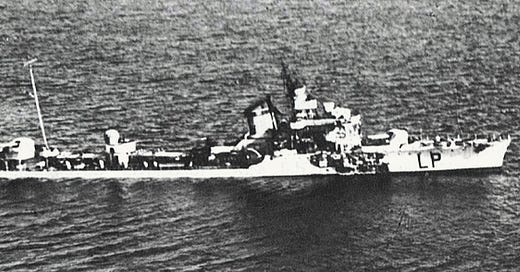Where Is the Wreck of the Destroyer "Lampo" Really Located? Three Compelling Hypotheses
Unraveling the Mystery of the Italian Destroyer Sunk off Cap Bon in 1943

The Mediterranean theater during World War II witnessed countless naval battles and tragedies, leaving a legacy of sunken ships scattered across its waters. One such vessel, the Italian destroyer Lampo, met its fate on April 30, 1943, during operations off Cap Bon, Tunisia. Despite numerous accounts of its sinking, the precise location of its wreck remains a topic of debate. Here, we explore three leading hypotheses about where the Lampo might rest.
1. The "Nearshore Wreck" Hypothesis
Some historians and amateur wreck hunters believe that the Lampo lies close to the Tunisian coast near Cap Bon. This theory is supported by reports from Allied forces that the destroyer was heavily damaged by aerial attacks before being scuttled or sinking while attempting to retreat to a safe harbor. Proponents of this hypothesis argue that the wreck should be in shallow waters, potentially visible through aerial or satellite imaging. However, repeated surveys of this area have yet to yield conclusive evidence.
2. The "Deep-Water Mystery" Hypothesis
Others argue that the Lampo may have sunk in deeper waters further offshore. This theory is based on accounts suggesting the ship was attempting to evade Allied forces when it suffered critical damage. If true, the wreck could rest at a depth that makes detection more challenging, requiring advanced sonar and remote-operated vehicles (ROVs) to locate it. This hypothesis aligns with the lack of confirmed sightings in the nearshore zones but has not yet been substantiated by any deep-water exploration efforts.
3. The "Misidentified Wreck" Hypothesis
A third possibility is that the wreck of the Lampo has already been found but misidentified as another vessel. The Mediterranean is a graveyard for countless ships from multiple nations, and many wrecks remain unnamed or incorrectly attributed. Underwater archaeologists and historians advocating this theory call for re-examination of known wrecks in the region, cross-referencing their characteristics with historical records of the Lampo's design and final moments.
Historical Context
The Lampo was part of the Italian Regia Marina and had already been sunk once during the war—at the Battle of Matapan in 1941—before being salvaged and returned to service. On its final mission in April 1943, the destroyer was transporting troops and supplies to Axis forces in Tunisia when it came under attack by Allied aircraft. The loss of the Lampo marked another blow to Axis naval operations in the closing months of the North African campaign.
Modern Efforts to Solve the Mystery
Efforts to locate the Lampo continue, driven by advancements in underwater exploration technology. Organizations specializing in maritime archaeology have expressed interest in the search, though limited funding and competing priorities often delay such missions. Additionally, Tunisian authorities and local divers occasionally report discoveries that could provide clues, though these leads have yet to result in a definitive identification.
Conclusion
The exact location of the Lampo remains elusive, but ongoing interest in its fate highlights the enduring allure of World War II naval history. Whether the wreck lies near Cap Bon’s shores, in deep offshore waters, or has been mistakenly identified as another ship, its discovery would offer a poignant reminder of the human and material cost of war.
Sources:
O’Hara, Vincent P. Struggle for the Middle Sea: The Great Navies at War in the Mediterranean Theater, 1940-1945.
Greene, Jack, and Alessandro Massignani. The Naval War in the Mediterranean, 1940-1943.
Italian Navy Historical Archives: Records on the Destroyer Lampo.
Tunisian Maritime Heritage Reports.
Interviews with local divers and historians in Cap Bon.





